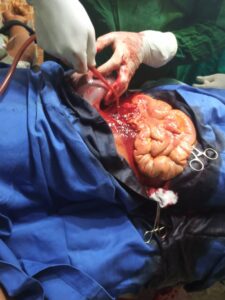

A traumatic injury is a type of injury that is closely associated with trauma and often cause by RTA while a splenic injury, which involves a ruptured spleen, is any injury to the spleen. The rupture of a normal spleen can be caused by trauma, such as a traffic collision.
Depending on the size of the injury, the injury leads to the expulsion of blood internally, it is an emergency condition irrespective of its severity.
Causes a Spleen injury
The spleen is the most frequent organ to be damaged in blunt trauma injuries involving the abdomen. This is true regardless of your age.
The following are among the frequent causes of spleen injuries:
- Motor vehicle accidents or road traffic accident (RTA)
- Injury during contact sports, such as football and hockey
- Bicycle accidents, such as falling into your bicycle’s handlebars
- Domestic violence
Certain illnesses can also lead to a spleen injury or ruptured spleen. In such cases, the spleen becomes swollen and the capsule-like covering becomes thin. This makes the organ especially fragile and more likely to rupture if the abdomen receives a direct hit.
Diseases that increase the risk for a ruptured spleen include:
- Infectious mononucleosis. In some cases, a ruptured spleen is the first sign of the illness.
- Blood (hematological) diseases such as hemolytic anemia and certain types of lymphoma
- Malaria
Signs and symptoms of injury in the spleen
Most especially spleen injury that is caused by illness can be diagnosed by:
- Abdominal pain
- Tenderness in the epigastrium
- Sharp pain in the left flank
However, if the injury occurs via traffic collision or direct accident, there will be:
- Rapid breathing
- Total or partial collapse
- Obvious numbness or loss of concentration
- Bleeding, though this depend on the severity
Worth-noting, the condition is a critical medical condition that calls for emergency response.


Treatment of traumatic injury and spleen injury.
No home remedy or local method can safe a situation like this, in fact, it handles with utmost care medically because, the bled blood internally has to be wiped off, ensure thorough opening and strict compliance to medical etiquette are observed.
Medically, a nonoperative approach is chosen in those who are hemodynamically stable with non-worsening symptoms During this period of nonoperative management strict bed rest between 24–72 hours with careful monitoring are key to the quick recovery of the patient
Our medic talks at ALTH
Lie no assurance in using local approach in treating a condition of such with huge possibility of internal bleeding, therefore, you are strongly advice to report the case to hospital if you can’t the ill fellow dear to you. Further delay worsens the condition hence, increasing death – life chance.

Recent Comments